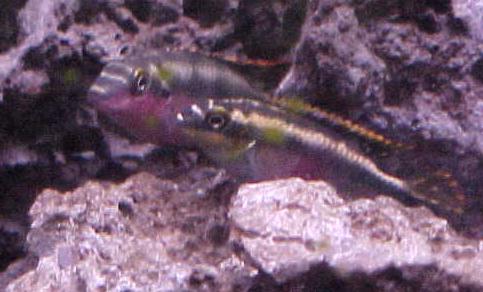Cichlid - Kribensis
Kribensis, Krib, Niger Cichlid, Purple Cichlid, Pallette Cichlid, Dwarf Rainbow Cichlid Scientific Name: Pelvicachromis pulcher
Sat, 5th July, 2025 - 10:13 pm GMT
Sponsor Ads:

Alternative Name
Kribensis, Krib, Niger Cichlid, Purple Cichlid, Pallette Cichlid, Dwarf Rainbow Cichlid Scientific Name: Pelvicachromis pulcherBasic Info
Male and female Kribensis can be differentiated by their appearances. Females tend to be more colorful and smaller than males. Males also have longer tails and a pointed anal fin. Mature male Kribensis will measure between seven and a half and 10 centimeters (three and four inches), while females measure between six and nine centimeters (two and a half and three and a half inches. Several color variants have been created in captivity and an albino variety has been commonly bred since the 1980s.
Health
Kribensis are relatively hardy fish that do well in a variety of conditions. Since they are tropical fish they should be kept in tropical temperatures between 24 and 26 degrees Celsius (75 to 79 degrees Fahrenheit), though they can be kept in warmer temperatures. Temperature may affect breeding. Kribs can live in a wide range of pH levels - between 6.4 and 8.5, though 7.0 seems to be the best. While these fish are not terribly hard to keep, like other cichlids they may not be well suited for absolute beginners. Breeding Breeding Kribensis in captivity is not difficult and is enjoyed by many Kribensis fanciers worldwide. Kribs are cave breeders and mate in pairs. The right environment is needed for them to breed. Clay pots or rocks should be provided to simulate the "cave" environment. You may also use coconut shells for a cave. If you choose to do this you need to buy a coconut and break it in half and clean it all out. Clean it well and then soak in boiling water for 30 minutes. Silica sand can also be used in the tank. The breeding tank should be a minimum size of 76 liters (20 gallons) and water should be maintained between 22.2 and 27.8 degrees Celsius (72 and 82 degrees Fahrenheit) and at a pH between 7.0 and 7.4. A large water change of 3/4 of the volume of the tank will often get the fish to start a mating display which will be followed shortly by the appearance of eggs (50 to 100 on average) on the roof of a cave or sometimes one parent will keep the eggs in their mouth. It is important not to disturb the egg-nests, as they may be eaten. Males may become territorial, so they should be given plenty of room in a breeding tank.Habitat
Fresh water fish They may also be found in slightly brackish low-lying streams as wellBehavior
The Kribensis is a beautiful and popular African cichlid that has gained something of a "cult-like" following among fanciers. Many hobbyists seem particularly fond of breeding Kribs. Kribensis Cichlids, also known as "Kribs" are usually classified as semi-aggressive fish. While they are not as aggressive as many cichlids, aggression will increase in overcrowded tanks, dirty water, and during mating season. It has been reported that females may be more aggressive than males. Like most cichlids they are not well suited for community tanks. They are known fin nippers and are aggressive when compared to regular community fish. Kribs have been known to kill slower moving, docile fish during the mating season. It should be noted that males tend to be more aggressive than females. Their aquariums should be well decorated with plants and hiding areas. Kribensis do enjoy hiding, so be sure to include plenty of rocks and driftwood. Kribs may nibble on plants, and some may uproot them as well; though generally most hobbyists report that they do not disturb plants. Java Moss and floating plants are very good additions in any Krib tank. The Kribensis is an active swimmer that spends most of its time in the lower regions of the tank. They are naturally curious fish that will travel to other areas of the tank when they are being fed. Kribensis are known to do quite well on commercial flake and pellet foods, as well as freeze dried varieties. They should also be given other foods to supplement their diet. Since they are omnivorous, variety is the key.Origin
AfricaHistory
Kribensis originate in Africa and are common in the Niger River Delta, in Nigeria. The Niger River Delta is freshwater, but slightly brackish. . The popularity of the Kribensis began with their introduction in the 1950s or 1960s. Kribs have been known by a variety of different names including, "Dwarf Rainbow Cichlid," "Niger Cichlid," "Pallette Cichlid," and "Purple Cichlid."Common Foods
Some good food choices include bloodworms, beef heart, brine shrimp, frozen daphnia, frozen plankton, glass worms, live fish, and tubifex worms.Sponsor Ads:
The windows registry is dead ground which microsoft keeps trying to plant in.
Cichlid - Kribensis
Coded by: BGID® | ALL RIGHTS RESERVED Copyright © 2000-2025
Disclaimer | Privacy | Report Errors / Contact | Credits
















